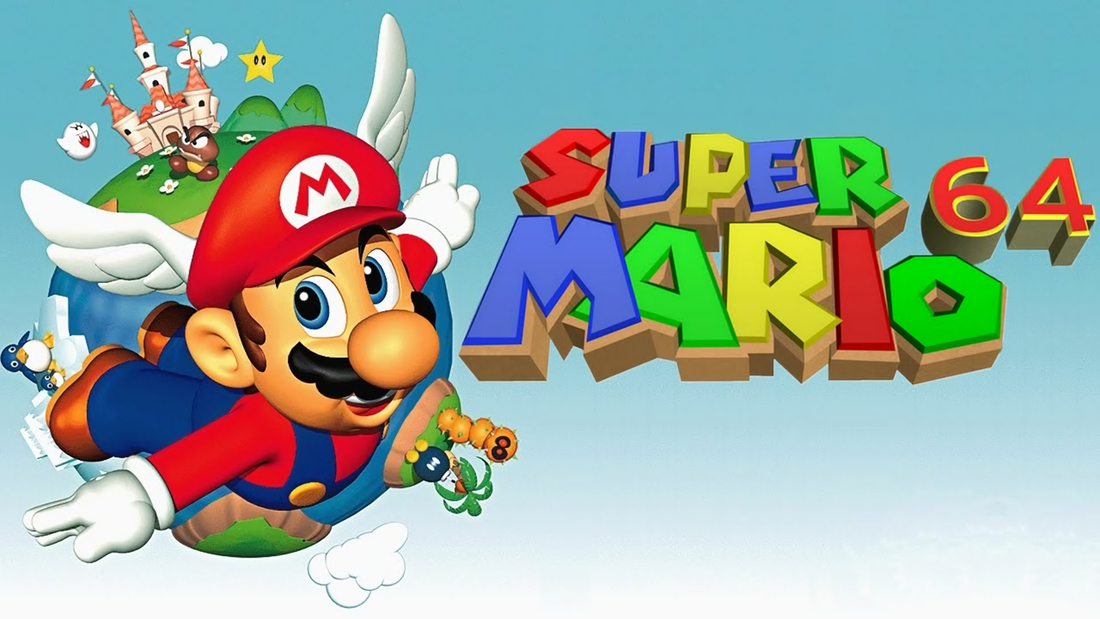
Super Mario 64: The Pioneer of 3D Platforming
Share
756 mots | Temps de lecture : 3 minute(s)
Super Mario 64 is a platform game developed by Nintendo EAD and released in 1996 on the Nintendo 64. The first installment in the Mario saga to go into full 3D , it redefined the codes of video games and set new standards in terms of gameplay, level design and handling. Even today, it remains one of the most influential titles in the history of video games, often cited as a revolution of the medium.
Genesis and ambitions of the project
Designed under the direction of the legendary Shigeru Miyamoto , the Super Mario 64 project aimed to deliver a fluid , intuitive , and immersive 3D platforming experience. The team focused on three pillars: precise character control , dynamic camera management, and freedom of exploration . The game was also one of the first to utilize the N64's analog stick controller, designed specifically for this transition. The result was acclaimed upon its release as a technical and conceptual feat .
Synopsis
Mario is invited to Princess Peach's castle to share a cake. But upon arrival, he discovers that Bowser has taken control of the castle, locking Peach and the Toads in parallel worlds accessible through magical paintings. To save his friends, Mario must collect Power Stars to open the locked doors and confront Bowser.
Revolutionary gameplay
Super Mario 64 introduces mechanics that have become standard:
- An interactive central hub (the castle) serving as a crossroads to the levels
- A semi-free camera , managed by a Lakitu cameraman
- Varied movements : triple jump, backflip, rodeo attack, wall jump…
- Non-linear exploration : each level offers multiple stars and objectives
The levels are truly semi-open environments , filled with secrets and shortcuts—a structure still emulated today.
The iconic levels
- Bob-omb Battlefield – Perfect Training Ground
- Whomp's Fortress – Vertical climbing and solid enemies
- Cool, Cool Mountain – Ice Sledding and Penguins
- Big Boo's Haunt – Haunted Mansion Full of Mysteries
- Tick Tock Clock – Difficulty varies depending on entry time
- Rainbow Ride – Aerial course requiring total control
Bowser Clashes
Bowser is fought three times in special arenas. To defeat him, you must grab his tail , spin him around, and then throw him against giant bombs. The final battle, Bowser in the Sky , remains one of the most iconic in the franchise, with its dramatic music and memorable staging.
Critical and commercial impact
- Metacritic : 94/100
- Sales : ≈ 11.9 million (N64 best seller)
- Awards : Game of the Year 1996 for many media outlets
The game has been praised for its technical innovation , accessible yet deep gameplay , and the freedom it offers players.
Reissues, remakes and legacy
- Super Mario 64 DS (2004) – Expanded version with additional characters
- Wii & Wii U Virtual Console – Faithful Ports
- Super Mario 3D All-Stars (2020) – Lightly Remastered Switch Compilation
The game still inspires:
- Creative mods and open source remakes
- An ultra-active speedrunning scene (16★, 70★, 120★)
- Legendary memes (“L is Real 2401”…)
Why is Super Mario 64 a cult classic?
- First perfectly mastered 3D platformer for the general public
- Innovative camera integrated as a character
- Rich and varied levels encouraging exploration
- Gameplay still smooth nearly 30 years later
- Massive influence on all subsequent 3D games
Conclusion
Super Mario 64 isn't just a great game—it's a cornerstone of gaming history . With its mastery of 3D, revolutionary gameplay, and vision ahead of its time, it gave players unparalleled freedom of movement in 1996. Whether you're a Mario fan, a retro enthusiast, or curious about the origins of modern gaming, Super Mario 64 remains an essential experience.
